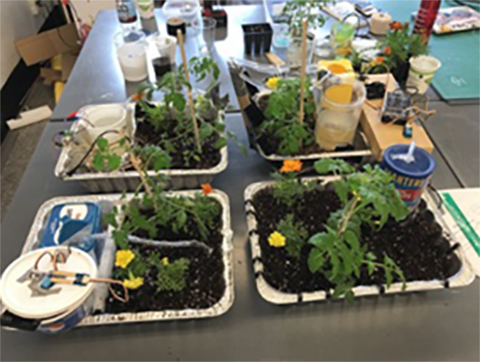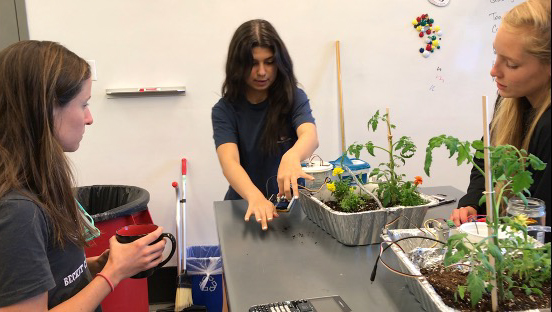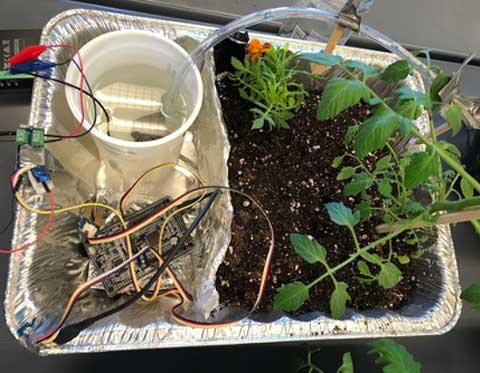Automatic Showers Bring May Flowers
Did you know World Water Day happens on March 22 every year, and it’s about focusing attention on the importance of water? What better chance to have your students put their coding and engineering design process to work while investigating water scarcity!
The World Bank reports that 40% of the Earth’s population faces extreme water scarcity. Population growth and climatic shifts are placing additional pressure on agricultural systems, pressure that is tapping a rapidly dwindling groundwater supply. With this in mind, and eager to learn more about the operation of our school’s aquaponic greenhouse, we leveraged the “Smart Water with TI-Innovator™” project to extend our students’ engineering skills and their appreciation of water conservation. The challenge: Create an autonomous and efficient watering system to deliver spring showers to our May flowers.
A little background …
In 2015, we brought the Engineer Your World (EYW) course, developed for high schools by The University of Texas at Austin, to our Pomfret School campus. The course stresses the use of the engineering design process (EDP) as a valuable approach to solving problems, first by identifying and describing the problem, and then ideating potential solutions, embodying designs of merit, and finalizing a finished design solution. EYW is project-based and collaborative, and each project has a dedicated customer. So, in the spring of 2018, when our coding unit came to a successful conclusion, we looked for a design challenge that incorporated technology, coding and environmental resource management. The “Smart Water with TI-Innovator™” project and activity bundle, created by our friends at Texas Instruments, proved to be the perfect platform for an awesome extension project with a very practical purpose. Check out the project resources for the TI-Nspire™ CX II graphing calculator using Python, the TI-Nspire™ CX and TI-Nspire™ CX II, or the TI-84 Plus CE graphing calculators.
Pomfret School has an aquaponic greenhouse, a space that grows in capacity through student innovations and solutions. Our customer, Annie O’Sullivan, is an environmental science teacher and the coordinator of campus sustainability initiatives. She asked our students to design an autonomous watering system that conserves water by operating only when the moisture level of the soil was low and night had fallen.
Designing the water system
The successful designs (figure 1) fashioned by our students, and developed after rounds of rapid prototyping, were made possible because the code necessary to measure soil humidity, detect ambient light, and trigger a water pump was included in the “Smart Water with TI-Innovator™” activity documentation. This jump-start on the code permitted students to “plug and play,” gain immediate access to the required sensors, and manipulate variables within the code tied to the customer’s design constraints. This easy on-ramp freed kids to explore questions about plant physiology and consider how dry the soil should become (and how quickly that might happen) between watering cycles. Through explorations, students came to understand the architecture of the code (construction, syntax and functionality) through this project and by working hard to meet the customer’s needs. At the end of the project, students had a chance to present their designs to their customer, O’Sullivan (figure 2). If your students are brand new to coding, straightforward lessons in 10 Minutes of Code are available for both TI-Basic and Python and can help get them up to speed quickly.


Students also had to carefully consider how to keep the technology dry, as well as how they designed their reservoir (figures 3 and 4).


This TI project had it all: a tangible application and a very real customer, several ways for students to craft solutions and find success, a way to extend our students’ understanding of code and sensor arrays while demonstrating the viability of the solution, and a commitment to the engineering design process. And, as an added bonus, the May flowers and learning that blossomed during this project lived long into the summer (figure 5), thanks to the good work of our EYW students.

TI also offers a range of water-related activities, of varying complexities. Check out some of these water-related activities on the Science Nspired page. Remember, World Water Day is coming, so get those lessons ready!
About the authors: Don Gibbs is a science instructor and school leader at Pomfret School in Connecticut. An experiential learning educator with 28 years of service in schools, Gibbs harnesses his passions for marine science, chemistry and engineering to create student-centered classrooms rich with discovery. He and Ellen Browne partner to teach Engineer Your World, an introductory, college-level engineering course designed for high school students by The University of Texas at Austin.
Ellen Browne is a Texas Instruments national instructor and lives at the Pomfret School in Pomfret, Connecticut. After teaching music for 25 years, she switched over to teaching math in 2003 and then she added engineering in 2015. She has always been captivated by the possibilities of TI technology in both subjects. Browne enjoys students, teaching, conducting TI workshops, and she is passionate about helping students and educators attain their goals.
Tagcloud
Archive
- 2025
- 2024
- 2023
- 2022
-
2021
- January (2)
- February (3)
- March (5)
-
April (7)
- Top Tips for Tackling the SAT® with the TI-84 Plus CE
- Monday Night Calculus With Steve Kokoska and Tom Dick
- Which TI Calculator for the SAT® and Why?
- Top Tips From a Math Teacher for Taking the Online AP® Exam
- Celebrate National Robotics Week With Supervised Teardowns
- How To Use the TI-84 Plus Family of Graphing Calculators To Succeed on the ACT®
- AP® Statistics: 6 Math Functions You Must Know for the TI-84 Plus
- May (1)
- June (3)
- July (2)
- August (5)
- September (2)
-
October (4)
- Transformation Graphing — the Families of Functions Modular Video Series to the Rescue!
- Top 3 Halloween-Themed Classroom Activities
- In Honor of National Chemistry Week, 5 “Organic” Ways to Incorporate TI Technology Into Chemistry Class
- 5 Spook-tacular Ways to Bring the Halloween “Spirits” Into Your Classroom
- November (4)
- December (1)
-
2020
- January (2)
- February (1)
- March (3)
- April (1)
- May (2)
- July (1)
- August (2)
- September (3)
-
October (7)
- Tips for Teachers in the time of COVID-19
- Top 10 Features of TI-84 Plus for Taking the ACT®
- TI Codes Contest Winners Revealed
- Best of Chemistry Activities for the Fall Semester
- Best of Biology Activities for the Fall Semester
- Best of Physics Activities for the Fall Semester
- Best of Middle Grades Science Activities
- November (1)
- December (2)
- 2019
-
2018
- January (1)
- February (5)
- March (4)
- April (5)
- May (4)
- June (4)
- July (4)
- August (4)
- September (5)
-
October (9)
- Art in Chemistry
- Which Texas Instruments (TI) Calculator for the ACT® and Why?
- Meet TI Teacher of the Month: Jessica Kohout
- Innovation in Biology
- Learning With Your Students
- A first-of-its-kind STEM strategy charts path to help educators
- #NCTMregionals Hartford 2018 Recap
- The Math Behind “Going Viral”
- Real-World Applications of Chemistry
-
November (8)
- Testing Tips: Using Calculators on Class Assessments
- Girls in STEM: A Personal Perspective
- 5 Teachers You Should Be Following on Instagram Right Now
- Meet TI Teacher of the Month: Katie England
- End-of-Marking Period Feedback Is a Two-Way Street
- #NCTMregionals Kansas City 2018 Recap
- Slope: It Shouldn’t Just Be a Formula
- Hit a high note exploring the math behind music
- December (5)
- 2017
- 2016
- 2015
